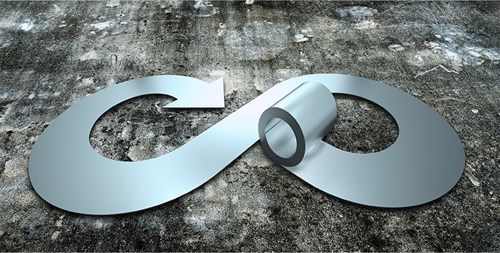The aluminium sector is a key player in circular economy since the material can be infinitely recycled, requiring a fraction of the energy used to produce the primary metal (5%). Hence, the life cycle analysis (LCA) becomes an essential tool to determine the environmental impacts associated with aluminium, from the acquisition of the primary materials to the final disposal. The recycling of aluminium constitutes one of the most important aspects of a product’s life cycle.
Aluminium life cycle
The life cycle of aluminium ranges from mining to recycling. Here are the steps [1] :
- Bauxite mining
- Alumina production
- Primary production of aluminium
- Aluminium processing
- Manufacturing of aluminium products
- Use phase
- Recycling and secondary production of aluminium
- Infinite loop from 4th to the 7th step
It is important to mention that there could be a first recycling before the use phase during the industrial production. In addition, the use phase can last for a long time (many years) since the lifespan of a building or a plane may spread on dozens of years, perhaps hundreds of years for infrastructures such as bridges.
Aluminium recycling
Aluminium is of the most recycled materials. Since the beginning of the industrial production, close to 75% of the world’s manufactured aluminium is still in use today.[2] Aluminium can be indefinitely recycled in a true closed loop. The recycling of aluminium is relatively simple and consumes less than 95% of the energy required for the electrolysis process.[3] In other words, it is more profitable to recycle aluminium than to dispose of it.
The recycling process
The main steps of the recycling process are the following:
- Collection
- Waste processing
- Casting
- Refinement
- Recasting
Aluminium can be indefinitely recycled without losing any of its properties or value. However, the value can fluctuate on the market. Generally, aluminium is combined to other materials in the manufacturing of finished products. It is necessary to separate the plastic components, ferrous elements, paints, etc. Obviously, the biggest quantity of new aluminium scrap originates from smelters; of which is not generally polluted and its alloy composition is known. The other scrap come from used finished products and construction parts.
Circular economy
We define circular economy as a system of production, exchange and consumption aiming to optimize the use of resources at each step of the life cycle of a product or service, in a circular logic, all while reducing the environmental footprint and contributing to the well-being of individuals and communities. AluQuébec facilitates the development of promising actions to encourage reuse, recycling and any other action of the value chain particularly via its Valorization and Recycling of aluminium workgroup.

References :
[1] Association de l’aluminium du Canada (2010). L’AVENIR S’IMAGINE EN ALUMINIUM. Document PDF. Repéré à https://www.cebq.org/wp-content/uploads/2015/09/Responsabilitecitoyenneetinnovation.pdf p.4
[2] Association de l’aluminium du Canada. (2008). L’avenir s’imagine en aluminium. Document PDF. Repéré à http://www.bape.gouv.qc.ca/sections/mandats/La%20Romaine/documents/DM14.pdf p.12
[3] Quantis Sustainability counts. (2010). L’analyse du cycle de vie comme outil de conception de bâtiments durables. Document PDF. Repéré à www.quantis-intl.com p.53
